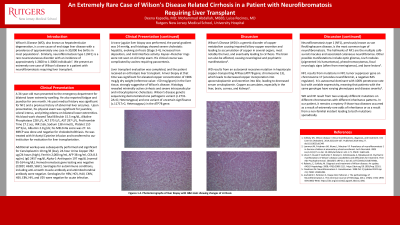Back


Poster Session B - Monday Morning
Category: Liver
B0553 - An Extremely Rare Case of Wilson's Disease Related Cirrhosis in a Patient With Neurofibromatosis Requiring Liver Transplant
Monday, October 24, 2022
10:00 AM – 12:00 PM ET
Location: Crown Ballroom

Has Audio
- DK
Deena Kapadia, MD
Rutgers New Jersey Medical School
Newark, NJ
Presenting Author(s)
Deena Kapadia, MD1, Mohammad Abdallah, MBBS2, Luisa Recinos, MD3
1Rutgers New Jersey Medical School, Newark, NJ; 2Rutgers NJMS, Newark, NJ; 3Saint Peter's University Hospital, Somerset, NJ
Introduction: Wilson’s Disease (WD) is a rare cause of end stage liver disease with a prevalence of approximately one case in 30,000 live births in most populations. Similarly, neurofibromatosis type 1 (NF1) is a rare neurocutaneous disorder with an incidence of approximately 1:2600 to 1:3000 individuals. This is an extremely rare case of WD in a patient with neurofibromatosis requiring liver transplant.
Case Description/Methods: A 34 year-old man presented to the ED for bilateral lower extremity swelling, fatigue, and jaundice for one month. His past medical history was significant for NF1 and abnormal liver enzymes. Labs showed total bilirubin 15.5, Alkaline Phosphatase 228, ALT 575, AST 297; MELD-Na score was 27. MRCP was negative for choledocholithiasis. Additional workup was significant for ceruloplasmin 10 (low), 24-hour urine copper 782 ug/24 hours (high); ferritin 2,000. Hemochromatosis gene testing was negative. AFP 38, CEA 8.3, IgG 2457, Alpha-1-Antitrypsin 197. Serologies for viruses and testing for autoimmune conditions were negative. Liver biopsy histology showed severe cholestatic hepatitis, Stage 3-4 cirrhosis, increased iron deposition, and mild interface activity. He received an orthotropic liver transplant. A liver biopsy was significant for elevated copper concentration, strongly suggestive of WD. Histology revealed minimally active cirrhosis, and severe intracanalicular and intracytoplasmic cholestasis. WD genetic sequencing demonstrated one pathogenic variant (c.2731-2A >G; Heterozygous) and one variant of uncertain significance (c.1171T >C; Heterozygous) in the ATP7B gene.
Discussion: WD is a genetic disorder of copper metabolism causing impaired biliary copper excretion, which leads to accumulation of copper in several organs, most notably the liver, eventually leading to cirrhosis. WD results from an autosomal recessive mutation in hepatocyte copper-transporting ATPase.
The hallmarks of NF1, the most common type of neurofibromatosis, are the multiple café-au-lait macules and associated cutaneous neurofibromas. It results from a mutation in NF1 tumor suppressor gene. It is autosomal dominant with 100% penetrance rate but with variable expressivity.
WD and NF result from two uniquely different mutations on different chromosomes and inheritance patterns. In our patient, it remains a mystery if those two diseases occurred as a result from extremely rare odds of inheritance or from a non-familial incident leading to both mutations sporadically.
Disclosures:
Deena Kapadia, MD1, Mohammad Abdallah, MBBS2, Luisa Recinos, MD3. B0553 - An Extremely Rare Case of Wilson's Disease Related Cirrhosis in a Patient With Neurofibromatosis Requiring Liver Transplant, ACG 2022 Annual Scientific Meeting Abstracts. Charlotte, NC: American College of Gastroenterology.
1Rutgers New Jersey Medical School, Newark, NJ; 2Rutgers NJMS, Newark, NJ; 3Saint Peter's University Hospital, Somerset, NJ
Introduction: Wilson’s Disease (WD) is a rare cause of end stage liver disease with a prevalence of approximately one case in 30,000 live births in most populations. Similarly, neurofibromatosis type 1 (NF1) is a rare neurocutaneous disorder with an incidence of approximately 1:2600 to 1:3000 individuals. This is an extremely rare case of WD in a patient with neurofibromatosis requiring liver transplant.
Case Description/Methods: A 34 year-old man presented to the ED for bilateral lower extremity swelling, fatigue, and jaundice for one month. His past medical history was significant for NF1 and abnormal liver enzymes. Labs showed total bilirubin 15.5, Alkaline Phosphatase 228, ALT 575, AST 297; MELD-Na score was 27. MRCP was negative for choledocholithiasis. Additional workup was significant for ceruloplasmin 10 (low), 24-hour urine copper 782 ug/24 hours (high); ferritin 2,000. Hemochromatosis gene testing was negative. AFP 38, CEA 8.3, IgG 2457, Alpha-1-Antitrypsin 197. Serologies for viruses and testing for autoimmune conditions were negative. Liver biopsy histology showed severe cholestatic hepatitis, Stage 3-4 cirrhosis, increased iron deposition, and mild interface activity. He received an orthotropic liver transplant. A liver biopsy was significant for elevated copper concentration, strongly suggestive of WD. Histology revealed minimally active cirrhosis, and severe intracanalicular and intracytoplasmic cholestasis. WD genetic sequencing demonstrated one pathogenic variant (c.2731-2A >G; Heterozygous) and one variant of uncertain significance (c.1171T >C; Heterozygous) in the ATP7B gene.
Discussion: WD is a genetic disorder of copper metabolism causing impaired biliary copper excretion, which leads to accumulation of copper in several organs, most notably the liver, eventually leading to cirrhosis. WD results from an autosomal recessive mutation in hepatocyte copper-transporting ATPase.
The hallmarks of NF1, the most common type of neurofibromatosis, are the multiple café-au-lait macules and associated cutaneous neurofibromas. It results from a mutation in NF1 tumor suppressor gene. It is autosomal dominant with 100% penetrance rate but with variable expressivity.
WD and NF result from two uniquely different mutations on different chromosomes and inheritance patterns. In our patient, it remains a mystery if those two diseases occurred as a result from extremely rare odds of inheritance or from a non-familial incident leading to both mutations sporadically.
Disclosures:
Deena Kapadia indicated no relevant financial relationships.
Mohammad Abdallah indicated no relevant financial relationships.
Luisa Recinos indicated no relevant financial relationships.
Deena Kapadia, MD1, Mohammad Abdallah, MBBS2, Luisa Recinos, MD3. B0553 - An Extremely Rare Case of Wilson's Disease Related Cirrhosis in a Patient With Neurofibromatosis Requiring Liver Transplant, ACG 2022 Annual Scientific Meeting Abstracts. Charlotte, NC: American College of Gastroenterology.
